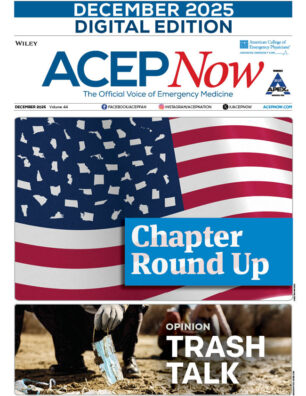CASE: A 63-year-old man has an unwitnessed cardiac arrest. EMS arrives to find him in ventricular fibrillation. They quickly begin resuscitation efforts, including defibrillation that does terminate the dysrhythmia. They give amiodarone as part of their protocol but wonder if it will make a meaningful difference.
Explore This Issue
ACEP Now: Vol 35 – No 11 – November 2016CLINICAL QUESTION: Are adult out-of-hospital cardiac arrest (OHCA) patients with refractory ventricular fibrillation or pulseless ventricular tachycardia who receive amiodarone or lidocaine more likely to survive to hospital discharge with good neurologic outcome?
BACKGROUND: Both lidocaine and amiodarone may be considered for the treatment of ventricular fibrillation or pulseless ventricular tachycardia that is unresponsive to defibrillation.1
There are two randomized control trials demonstrating that the use of amiodarone led to more patients with a return of spontaneous circulation at the time of hospital arrival when compared to lidocaine or placebo.2,3 However, these early benefits did not translate into a benefit in survival to hospital discharge or neurologically intact survival.
In adult OHCA patients with refractory ventricular fibrillation or pulseless ventricular tachycardia, amiodarone or lidocaine is unlikely to provide a clinically important benefit.
REFERENCE: Kudenchuk RJ, Brown SP, Daya M, et al. Amiodarone, lidocaine, or placebo in out-of-hospital cardiac arrest. N Engl J Med. 2016;374(18):1711-1722.
- Population: Adult patients with nontraumatic OHCA and shock-refractory ventricular fibrillation or pulseless ventricular tachycardia after one or more shocks anytime during resuscitation.
- Exclusions: Patients who had already received open-label intravenous lidocaine or amiodarone during resuscitation or had known hypersensitivity to these drugs.
- Intervention: Rapid bolus of amiodarone or lidocaine.
- Comparison: Placebo.
- Outcome:
- Primary: Survival to hospital discharge.
- Secondary: Favorable neurologic function at discharge (modified Rankin Scale of 3 or less).
AUTHORS’ CONCLUSIONS: Overall, neither amiodarone nor lidocaine resulted in a significantly higher rate of survival or favorable neurologic outcome than the rate with placebo among patients with OHCA due to initial shock-refractory ventricular fibrillation or pulseless ventricular tachycardia.
KEY RESULTS: There were 7,051/37,889 (18.6 percent) of patients with nontraumatic OHCA that had shock-refractory ventricular fibrillation or pulseless ventricular tachycardia. The intention-to-treat population consisted of 4,653 patients, and the per-protocol population consisted of 3,026 patients.
There was no statistical difference in the primary outcome of survival to hospital (amiodarone 24.4 percent, lidocaine 23.7 percent, and placebo 21.0 percent).
- Absolute difference: amiodarone versus placebo 3.2 percent (95 percent CI, -0.4 to 7.0; P=0.08)
- Absolute difference: lidocaine versus placebo 2.6 percent (95 percent CI, -1.0 to 6.3; P=0.16)
There was also no statistical difference in the secondary outcome of favorable neurologic function at discharge (amiodarone 18.8 percent, lidocaine 17.5 percent, and placebo 16.6 percent).
EBM COMMENTARY:
1) Statistical versus clinical significance: The study authors did not demonstrate a statistical difference in their primary outcome. However, there is a difference between statistical significance and clinical significance. The observed approximately 3 percent difference in survival to hospital discharge with treatment, if true, would translate into 1,800 lives saved yearly in North America for OHCA. They would have needed to enroll about 9,000 patients to establish if the 3 percent difference was statistically significant.
2) Intention-to-treat versus per-protocol analysis: The primary endpoint of this study was based on a per-protocol analysis of the cohort, which can introduce bias and make the treatment look better. They excluded 1,627 patients for a number of reasons. When they did an intention-to-treat analysis, the trend toward improvement became even less.
- Survival to hospital discharge: amiodarone 19 percent, lidocaine 18.4 percent, and placebo 17.6 percent
- Favorable neurologic function at discharge: amiodarone 14.4 percent, lidocaine 13.5 percent, and placebo 13.8 percent
3) Subgroup analysis: There were statistical differences observed in some prespecified subgroups. These should be viewed with caution and considered observational by nature. It is also important to remember that subgroup analysis can easily be misleading because the risk of type 1 error (incorrect rejection of a true null hypothesis) increases as the investigator makes more observations.
BOTTOM LINE: In adult OHCA patients with refractory ventricular fibrillation or pulseless ventricular tachycardia, amiodarone or lidocaine is unlikely to provide a clinically important benefit.
CASE RESOLUTION: The patient has a return of spontaneous circulation but does not survive to hospital discharge.
Thank you to Dr. Rory Spiegel from EM Nerd for his help with this review. Dr. Spiegel is a clinical instructor at the University of Maryland and a recent graduate of Stony Brook’s resuscitation fellowship.
Remember to be skeptical of anything you learn, even if you heard it on the Skeptics’ Guide to Emergency Medicine.
References
- Link MS, Berkow LC, Kudenchuk PJ, et al. Part 7: adult advanced cardiovascular life support: 2015 American Heart Association guidelines update for cardiopulmonary resuscitation and emergency cardiovascular care. Circulation. 2015;132(18 Suppl 2):S444-S464.
- Kudenchuk PJ, Cobb LA, Copass MK, et al. Amiodarone for resuscitation after out-of-hospital cardiac arrest due to ventricular fibrillation. N Engl J Med. 1999;341(12):871-878.
- Dorian P, Cass D, Schwartz B, et al. Amiodarone as compared with lidocaine for shock-resistant ventricular fibrillation. N Engl J Med. 2002;346(12):884-890.
Pages: 1 2 | Multi-Page





